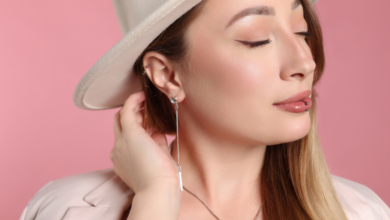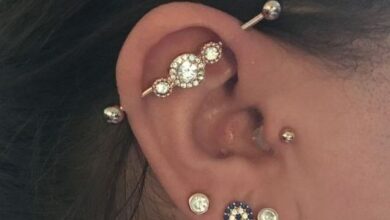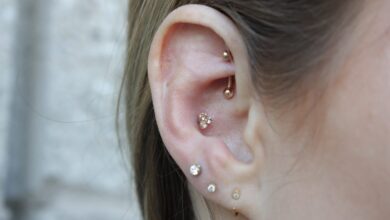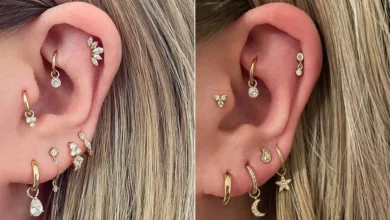
If you’ve ever wondered about the different types of ear piercings and how to rock them with style, look no further than Stylish.ae’s Ultimate Guide to Ear Piercings. From the classic lobe piercing to the trendy cartilage piercing, this comprehensive guide has got you covered. Whether you’re a piercing newbie or a seasoned pro, discover the latest trends, healing process, and aftercare tips for each piercing style. Get ready to elevate your ear game and express your unique personality through the art of ear piercing.
Types of Ear Piercings
When it comes to ear piercings, there are so many options to choose from! Each piercing has its unique placement, procedure, healing time, and aftercare tips. Whether you’re a piercing enthusiast or considering getting your first ear piercing, it’s essential to understand the different types. Let’s explore the wide variety of ear piercings available.
Lobe Piercing
Lobe piercing is the most common and widely recognized type of ear piercing. This classic piercing is located on the fleshy lower part of the earlobe. It’s one of the least painful and easiest piercings to heal, making it ideal for piercing beginners.
Helix Piercing
Helix piercing is placed on the upper, outer edge of the ear cartilage. It can be done on the forward helix (closer to the face) or the outer helix. This piercing can be a single stud or a cluster of earrings, allowing for various jewelry options. It’s a popular choice among individuals who want a stylish and edgy look.
Tragus Piercing
The tragus is the small, rounded cartilage in front of the ear canal. Tragus piercing involves placing jewelry through this cartilage, creating a unique and trendy look. It’s a relatively small and delicate area, requiring an experienced piercer to ensure a smooth procedure.
Conch Piercing
Conch piercing is located in the center of the ear’s cartilage, either in the outer conch or the inner conch. This piercing can be done with a hoop or a stud, allowing for a variety of jewelry choices. It’s a versatile piercing that adds an element of individuality to your ear jewelry collection.
Rook Piercing
The rook is the fold of cartilage located in the upper inner part of the ear, above the tragus. Rook piercing is becoming increasingly popular due to its unique placement and aesthetic appeal. It requires precise positioning and careful aftercare to ensure a successful healing process.
Daith Piercing
The daith is the small fold of cartilage located just above the ear canal. Daith piercing has gained popularity in recent years, with many people embracing its stylish and alternative look. This piercing allows for a range of jewelry options, from delicate rings to ornate studs.
Industrial Piercing
Industrial piercing, also known as scaffold or bar piercing, involves connecting two separate piercings on the upper ear cartilage with a long, straight barbell. This piercing creates a bold and eye-catching look, but it requires extra care during the healing process due to the extended wound.
Snug Piercing
Snug piercing is placed in the inner cartilage ridge of the ear, above the anti-tragus. It’s a unique and visually striking piercing that adds a touch of edginess to your ear jewelry collection. Due to the snug’s complex anatomy, it’s crucial to choose an experienced piercer for a successful procedure.
Orbital Piercing
Orbital piercing involves two piercings connected with a single piece of jewelry, creating a circular or orbital effect. One hole is placed near the outer rim of the ear, while the other is positioned further inside the earlobe. This piercing allows for endless creativity when it comes to jewelry selection.
Cartilage Piercing
Cartilage piercing refers to any piercing that involves the ear’s upper cartilage area. This category includes helix, conch, rook, daith, industrial, snug, and orbital piercings. Cartilage piercings offer a vast range of possibilities for expressing your personal style and are beloved by piercing enthusiasts around the world.

Lobe Piercing
Placement
Lobe piercing is typically done on the fleshy lower part of the earlobe, where the tissue is soft and easy to pierce. It can be placed anywhere along the lobe, depending on your desired aesthetic.
Procedure
During a lobe piercing, a sterilized hollow needle or a piercing gun is used to create a small hole in the earlobe. The piercer will then insert the jewelry of your choice, usually a stud, hoop, or barbell.
Healing Time
On average, lobe piercings take about 6 to 8 weeks to heal fully. However, it’s important to note that healing time can vary depending on individual factors such as aftercare, lifestyle, and overall health.
Aftercare Tips
To ensure a smooth healing process, it’s crucial to follow proper aftercare guidelines for your lobe piercing. Clean the piercing twice a day with a saline solution or an aftercare solution recommended by your piercer. Avoid touching the piercing with dirty hands and refrain from changing the jewelry too early to prevent irritation. Be gentle while cleaning and drying the area, and avoid sleeping on the pierced side during the healing period.

Helix Piercing
Placement
Helix piercing is located on the upper, outer edge of the ear’s cartilage. It can be done on the forward helix, which is closer to the face, or the outer helix.
Procedure
During a helix piercing, a sterilized hollow needle or a piercing gun is used to create a hole in the cartilage. The piercer will then insert the jewelry of your choice, which can be a stud, hoop, or barbell.
Healing Time
The healing time for helix piercings can vary but generally takes anywhere from 6 to 12 months. This extended healing duration is due to the cartilage’s slower healing process compared to soft tissue piercings, such as lobe piercings.
Aftercare Tips
To promote proper healing, it’s essential to keep your helix piercing clean. Clean the piercing twice a day with a saline solution or an aftercare solution recommended by your piercer. Avoid sleeping on the pierced side and be cautious when brushing or styling your hair to prevent accidental pulling or tugging on the jewelry. Avoid swimming in pools or hot tubs until the piercing is fully healed to minimize the risk of infection.
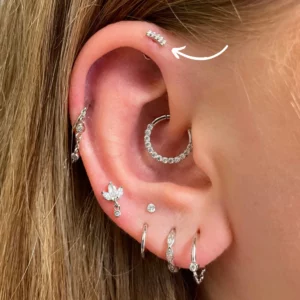
Tragus Piercing
Placement
Tragus piercing is placed on the small, rounded cartilage in front of the ear canal, known as the tragus.
Procedure
During a tragus piercing, a sterilized hollow needle or a piercing gun is used to create a hole in the tragus cartilage. Once the piercing is made, the piercer will insert a small stud or hoop that best suits your style.
Healing Time
The tragus piercing healing process can take approximately 6 to 8 months. Cartilage piercings generally require a more extended healing period due to the thicker and less vascular nature of the cartilage tissue.
Aftercare Tips
To ensure a successful healing process, clean your tragus piercing twice a day using a saline solution or an aftercare solution recommended by your piercer. Avoid touching or twisting the jewelry unnecessarily, as this can lead to irritation or infection. Protect the piercing from hair products, foreign objects, and excessive water exposure during the healing period. Be patient and gentle with your tragus piercing, and consult your piercer if you experience any unusual symptoms.
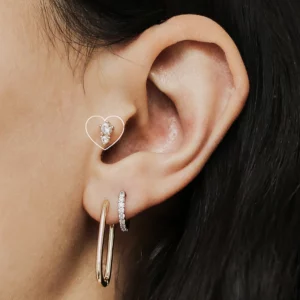
Conch Piercing
Placement
Conch piercing is situated in the center of the ear’s cartilage and can be done on either the outer conch or the inner conch.
Procedure
During a conch piercing, a sterilized hollow needle is used to create a hole in the chosen part of the conch. The piercer will then carefully insert the jewelry, which can vary from studs to captive bead rings or even barbells.
Healing Time
Conch piercings typically require a healing time of 6 to 12 months, depending on your body’s healing abilities and aftercare practices.
Aftercare Tips
To support the healing process, clean your conch piercing twice a day with a saline solution or an aftercare solution suggested by your piercer. Avoid sleeping on the pierced side during the healing period and refrain from touching or playing with the jewelry. Be cautious when brushing or washing your hair to prevent snagging the jewelry. If you experience excessive swelling or unusual pain, consult your piercer or a healthcare professional.

Rook Piercing
Placement
The rook piercing is positioned in the fold of cartilage located in the upper inner part of the ear, above the tragus.
Procedure
During a rook piercing, a sterilized hollow needle is used to create a hole in the rook cartilage. The piercer will then insert the jewelry, typically a curved barbell or a small hoop, depending on your preference and anatomy.
Healing Time
The healing time for rook piercings usually ranges from 6 to 9 months. However, the healing process can be influenced by factors such as your body’s response to healing, aftercare practices, and jewelry selection.
Aftercare Tips
To promote proper healing, clean your rook piercing twice a day using a saline solution or an aftercare solution suggested by your piercer. Avoid sleeping on the pierced side and be cautious when styling your hair to prevent accidental pulling or snagging of the jewelry. If you participate in physical activities or contact sports, take extra precautions to protect the piercing from potential injuries. If you experience any concerning symptoms, consult your piercer or a healthcare professional.

Daith Piercing
Placement
The daith piercing is located in the small fold of cartilage just above the ear canal.
Procedure
During a daith piercing, a sterilized hollow needle is used to create a hole in the daith cartilage. The piercer will then carefully insert the jewelry, ranging from small hoops to intricate studs.
Healing Time
The daith piercing healing process typically takes 6 to 9 months but can vary from person to person. It’s important to be patient and consistent with aftercare routines to ensure a smooth healing experience.
Aftercare Tips
To support the healing process, clean your daith piercing twice a day with a saline solution or an aftercare solution advised by your piercer. Avoid sleeping on the pierced side and be cautious when using earphones or headsets to prevent unnecessary pressure on the piercing. Be mindful of hairstyles that may pull or brush against the jewelry. If you experience any persistent pain or signs of infection, seek guidance from your piercer or a healthcare professional.

Industrial Piercing
Placement
Industrial piercing, also known as scaffold or bar piercing, involves connecting two separate piercings on the upper ear cartilage with a long, straight barbell.
Procedure
During an industrial piercing, a piercer will create two holes, typically in the forward helix and the outer helix, to accommodate the straight barbell. The barbell is then inserted through the piercings, creating an eye-catching and unique look.
Healing Time
Due to the challenging nature of industrial piercings, the healing process can take anywhere from 6 to 12 months or longer. The extended healing time is primarily attributed to the complex nature of the piercing and the need for continuous care.
Aftercare Tips
To ensure a successful healing process, clean your industrial piercing twice a day using a saline solution or an aftercare solution recommended by your piercer. Avoid touching or twisting the jewelry unnecessarily and be mindful of clothing and hairstyles that may catch or pull on the piercing. Protect the piercing from excessive moisture, such as in swimming pools or hot tubs, until it’s fully healed. Consult your piercer if you experience any significant discomfort, excessive swelling, or signs of infection.

Snug Piercing
Placement
Snug piercing is placed in the inner cartilage ridge of the ear, above the anti-tragus.
Procedure
During a snug piercing, a piercer will use a sterilized hollow needle to create a hole in the snug cartilage. The jewelry, such as a captive bead ring or a curved barbell, is then carefully inserted through the fresh piercing.
Healing Time
Snug piercings typically require an extended healing time of 6 to 12 months or longer due to the location in the thick and less vascular cartilage.
Aftercare Tips
To ensure a smooth healing process, clean your snug piercing twice a day with a saline solution or an aftercare solution recommended by your piercer. Avoid sleeping on the pierced side and be cautious when brushing or washing your hair to prevent accidental pulling or snagging of the jewelry. Protect the piercing from excessive moisture, such as in swimming pools or hot tubs, and avoid changing or removing the jewelry before it’s fully healed. If you experience persistent discomfort or signs of infection, consult your piercer or a healthcare professional.

Cartilage Piercing
Placement
Cartilage piercing encompasses various types, including helix, conch, rook, daith, industrial, snug, and orbital piercings. These piercings are all situated in different areas of the ear’s cartilage.
Procedure
The procedure for each cartilage piercing involves creating a hole in the specific cartilage area using a sterilized hollow needle. The piercer will then insert the jewelry of your choice through the fresh piercing.
Healing Time
Cartilage piercings generally require an extended healing time compared to lobe piercings. The healing duration can vary depending on factors such as the specific piercing location, aftercare practices, and individual healing abilities.
Aftercare Tips
As with any cartilage piercing, clean your piercing twice a day using a saline solution or an aftercare solution recommended by your piercer. Avoid touching, twisting, or playing with the jewelry unnecessarily, as this can prolong the healing process or lead to complications. Be mindful of your daily activities and avoid situations that may put excessive pressure or strain on the piercing. If you experience any concerning symptoms or difficulties during the healing period, consult your piercer or a healthcare professional.
Remember, ear piercings are a form of self-expression and should be approached with care and consideration. Always choose a reputable and experienced piercer, follow their aftercare instructions diligently, and listen to your body throughout the healing process. With proper care and attention, your ear piercing journey can be a rewarding and stylish experience!
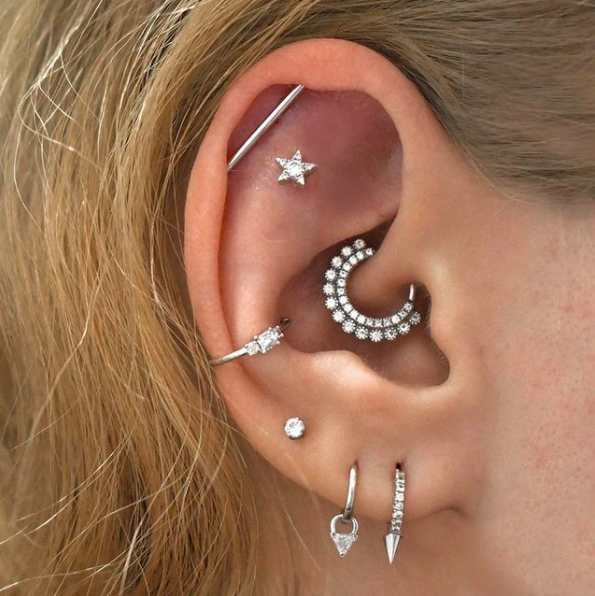
The 16 Types of Ear Piercings: Choosing Based on Pain and Placement(Opens in a new browser tab)
A Guide to Conch Piercings and Aftercare(Opens in a new browser tab)
10 Things You Need to Know About Tragus Piercings(Opens in a new browser tab)

